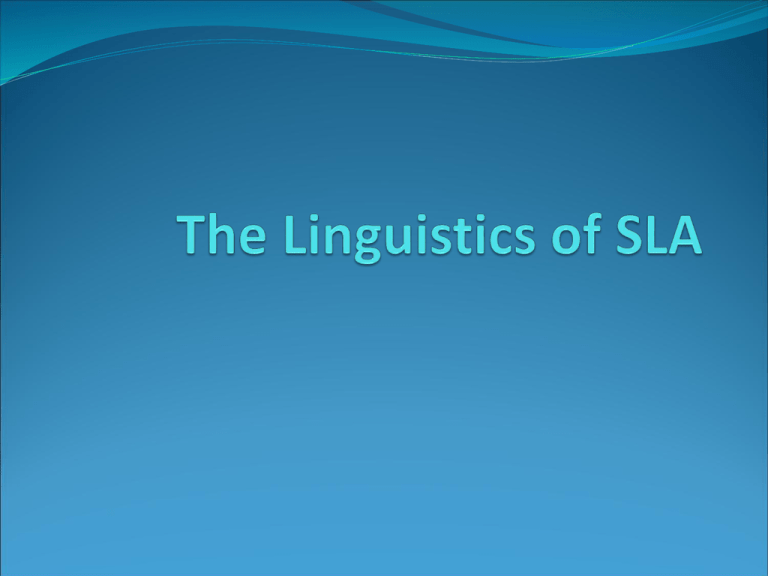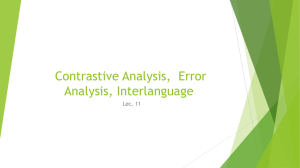The Linguistics of SLA
advertisement

The Nature of Language Languages are systematic - We understand the principles by which the words are combined to express meaning Languages are symbolic - Sequences of sounds or letters don’t inherently possess meaning. - The meanings of symbols in a language come through the tacit agreement between the speakers Languages are social - Each language reflects the social requirements of the society that uses it. - Language is the expressive dimension of culture Lexicon (vocabulary) Phonology (sound system) Morphology ( word structure) Syntax (grammar) Discourse • word meaning •Pronunciatio n •Grammatical category/ parts of speech •Possible occurences in combination with other words and in idioms •Speech sounds that make a difference in meaning •Possible sequences of consonants and vowels • intonation patterns(stres s, pitch and duration) and tone •Rhythmic patterns •Parts of words that have meaning (morphemes) •Inflections •Prefixes and suffixes •Word order •Agreement between sentence elements •Ways to form questions, negate assertion and focus structure information within stcs •Ways to connect sentences •Structure for telling stories, engaging in conversation •Scripts for interacting and for events Early Approaches to SLA Contrastive Analysis (Hypothesis) (CAH) - Approach to the study of SLA which involves predicting and explaining learner problems based on a comparison of L1 and L2 to determine similarities and differences. - Got the influence from linguistics and psychology, Structuralism and Behaviorism - The goal of CAH is to increase efficiency in L2 teaching and testing. - The focus is on the surface forms of both L1 and L2 systems and describing an comparing the languages one level at a time. - Early proponents of CAH assumed that language acquisition involves habit formation in a process of SR-R - There will be transfer in learning, of elements acquired (habituated) in L1 to the target L2. (Positive or negative (interference)) - The CAH approach was not adequate for the study of SLA because: 1. The behaviorist learning theory to which it is tied can’t explain the logical problem of language learning 2. CAH analysis were not always validated by evidence from actual learner errors. 3. Many of the L2 problems which CAH predicts do not emerge, it doesn’t account for many learner errors, and much predicted positive transfer doesn’t materialize. Error Analysis The first approach to the study of SLA which includes an internal focus on learners’ creative ability to construct language. Based on the description and analysis of actual learner errors in L2, rather than on idealized linguistic structures attributed to native speakers of L1 and L2. EA augmented/replaced CAH in the early 1970w because: 1. Prediction made by CAH did not always materialize in actual learner errors. 2. The exclusive focus on surface level forms and patterns by structural linguists shifted to concern on the underlying rules. 3. There was a shift from behaviorism to mentalism in explaining language acquisition, with emphasis on the innate capacity of the language learner rather than on external influences. 4. The study of SLA was no longer motivated by teaching concerns as it had been for CAH. Researchers began to separate issues in SLA from pedagogical concerns. No 2 and 3 were mostly influenced by Chomsky’s Transformational-Generative Grammar.











